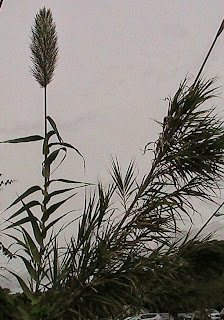 Seeds from trees, bushes, flowers, and grasses are easily spread by animals and humans. The seeds cling to the animal's fur and our clothing to be dropped. The seeds are also spread by the wind and the birds spread the seeds as well. Once you have invasive plants, they are difficult to eradicate.
Seeds from trees, bushes, flowers, and grasses are easily spread by animals and humans. The seeds cling to the animal's fur and our clothing to be dropped. The seeds are also spread by the wind and the birds spread the seeds as well. Once you have invasive plants, they are difficult to eradicate.As an experiment, the Master Gardner let a stand of reeds grow in his yard where he could somewhat control the plant's environment and observe how the reeds did during the seasons. The reeds did very well; too well. He found that when he tried to dig up the reeds with a sharp shovel, the rhizomes were hard as rock.
The tall reeds are also known as Giant Reeds. They are grasses that grow up to 12 feet tall. The stalk can be an inch thick and the leaves are long, sharp, and greenish. The leaves resemble blades. The Common Reed is native to Florida and may be found on marshes or other waters. This plant spreads quickly by its rhizomes and seeds.
The Burma Reed or the Silk Weed is found in Southern Florida and it is listed on the Florida Noxious Weed List. It means that it is unlawful to introduce, multiply, possess, move, or release this plant without a permit issued by the state. The Burma Reed was first introduced as an ornamental plan (University of Florida IFAS). Although the reeds are attractive, be vigilant.
The above picture shows the invasive air potato making its way to the end of the reed's "tassel"-- double trouble. Honestly, by looking at pictures of the various reeds, I cannot tell the difference between the different reeds: I would consider them all as invasive plants.
Thank you for visiting my blog.

Thanks to sharing this post its all information is really great for gardening.
ReplyDeletePole Saw, Tree Cutting Tools